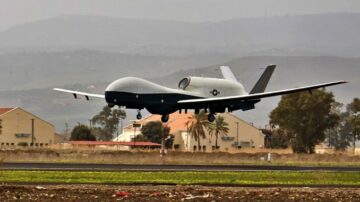
The giant “Sky Dew” aerostat carries sensors that can identify incoming long-range missiles and aircraft.
On Nov. 3, 2021, the Israeli Air Force announced it is about to deploy its balloon-mounted radar system with advanced missile and aircraft detection. The blimp, one of the world’s largest according to the official statements, has completed the final testing and will soon be deployed in the north of the country (the exact location and date were not specified), to beef up the air defenses in a region where Israel has observed a “proliferation of Iranian drones and cruise missiles“.
Dubbed “Sky Dew”, the new technology is based on an aerostat air platform developed by the American company TCOM. It was developed in a joint venture by Israel’s Missile Defense Organization and the United States’ Missile Defense Agency over the last few years.
Even though Israel already fields an array of ground-based and airborne early warning systems to detect incoming threats, the new aerostat system is meant to complement and improve existing capabilities by placing the sensors at high altitude for days (similar systems can remain airborne for 20 days).
היום (ד׳), החלה הצבה של פלטפורמה אווירית, מהגדולות מסוגה בעולם, שתשמש לצרכי גילוי והתרעה של איומים מתקדמים. זאת לאחר תהליך פיתוח וייצור של מספר שנים על ידי מנהלת ׳חומה׳ במפא״ת, הסוכנות להגנה מטילים האמריקאי, ובשיתוף עם חיל-האוויר והתעשייה האווירית. pic.twitter.com/QGgUa1rTQz
— Israeli Air Force (@IAFsite) November 3, 2021
“The elevated sensor system provides a significant technological and operational advantage for early and precise threat detection,” said Boaz Levy, CEO of the Israel Aerospace Industries, which helped develop the system, according to the Times of Israel.
“In several flight test campaigns conducted in recent months, we have demonstrated the outstanding capabilities of Israel’s multi-tier missile defense — including against cruise missiles,” the director of Israel’s Missile Defense Organization, Moshe Patel, said. The multi-tier defense for missile interception, includes the Iron Dome and David’s Sling systems for mid-range and Arrow 3 for long-range ones.
No additional technical details/specifications about the “Sky Dew” were released but the Youtube clip that shows the massive blimp being inflated from several angles.
The idea of using aerostats to carry radar systems is not new. Since the beginning of the century, tethered “spy balloons” complement traditional ground based radars by detecting incoming threats flying too low for radars to pick them up. They can remain “on station” for several days, saving money spent on crew, fuel, maintenance and other costs of the traditional fixed-wing platforms.
In 2003, blimps belonging to the Persistent Threat Detection System (PTDS) started to operate in Afghanistan and Iran. According to Lockheed Martin, that produced the intelligence gathering system, in all 66 PTDS large helium-filled aerostats (the last of those was delivered in 2012) were put into action to provide U.S. Army soldiers with long-range intelligence, surveillance, reconnaissance (ISR) and communication assistance. The 35-m PDTS can carry a payload of 500 kg, including Wescam Electro-Optic (EO)/infrared (IR) sensors, radars, communication relay systems and GPS and transfer live data/imagery to ground receivers.
The aerostat for the PTDS is smaller than the aerostat used in the Tethered Aerostat Radar System (TARS), which provides surveillance along the US-Mexican border. The PTDS aerostat is 115 feet long with 74,000 cubic feet of helium and a 1,102 pound payload; the TARS aerostat made by Lockheed Martin is 1,640 feet long with 420,000 cubic feet of helium and a 2,205 pound payload.
Between 2009 and 2011 four dedicated blimps were built as part of the U.S. Army-led JLENS (Joint Land Attack Cruise Missile Defense Elevated Netted Sensor System). JLENS would have had a higher payload (1,600 kg vs 500 kg) and flight ceiling (3,000 m vs 1,500 m) than the PTDS but following cost overruns, declining support in Congress, and criticism that followed a snapped tether which allowed one craft moored at Aberdeen Proving Ground, Maryland to drift on a 100-mile uncontrolled descent across Pennsylvania, dragging its cable tether which damaged power lines and cut power to 20,000 homes, the program was first suspended than discontinued by 2017.
In 2012, in Israel, an IDF observation airship crashed on the Israeli side of the Gaza border during a routine surveillance deployment when a civilian crop duster flying by hit its cable. As a consequence of the incident, the balloon crashed whereas the crop duster landed safely.
Source: https://theaviationist.com/2021/11/04/israel-sky-dew/
- "
- 000
- 102
- 2021
- 420
- Action
- Additional
- ADvantage
- Aerospace
- Air Force
- aircraft
- All
- American
- announced
- Army
- Australia
- avatar
- aviation
- Beef
- blogs
- Books
- border
- Campaigns
- ceo
- Communication
- company
- Congress
- Costs
- credit
- Crime
- crop
- cruise
- Defense
- Detection
- develop
- Director
- Drones
- Early
- editor
- Engineering
- Europe
- Feet
- Fields
- First
- flight
- founder
- freelance
- Fuel
- gps
- graduate
- High
- HTTPS
- idea
- identify
- IDF
- image
- Including
- industries
- industry
- Intelligence
- Iran
- Israel
- Israeli
- IT
- Italy
- joint venture
- journalist
- large
- launch
- location
- Long
- major
- Maryland
- Military
- money
- months
- North
- official
- organization
- Other
- Others
- Pennsylvania
- pilot
- Planes
- platform
- Platforms
- player
- power
- private
- Produced
- Program
- radar
- saving
- sensors
- started
- support
- surveillance
- Syria
- system
- Systems
- Technical
- Technology
- test
- Testing
- Tether
- threat detection
- threats
- top
- u.s.
- United
- venture
- Video
- war
- worldwide
- years
- youtube













